
The Danish West Indies or Danish Antilles or Danish Virgin Islands were a Danish colony in the Caribbean, consisting of the islands of Saint Thomas with 32 square miles (83 km2); Saint John with 19 square miles (49 km2); and Saint Croix with 84 square miles (220 km2). The islands have belonged to the United States since they were purchased in 1917. Water Island was part of the Danish West Indies until 1905, when the Danish state sold it to the East Asiatic Company, a private shipping company.
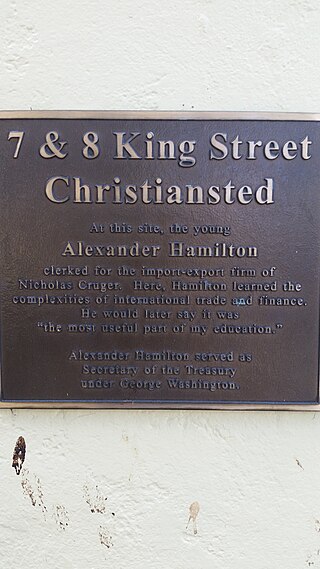
Saint Croix is an island in the Caribbean Sea, and a county and constituent district of the United States Virgin Islands (USVI), an unincorporated territory of the United States.
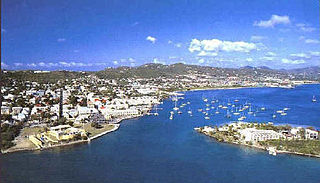
Christiansted is the largest town on Saint Croix, one of the main islands composing the United States Virgin Islands, a territory of the United States of America. The town is named after King Christian VI of Denmark.
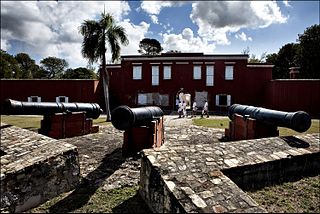
Frederiksted is both the town and one of the two administrative districts of St. Croix, U.S. Virgin Islands. It is a grid-planned city, designed by surveyor Jens Beckfor, originally to 14x14 blocks but built 7x7 to enhance the island commerce in the 1700s. Frederiksted has fewer than 1,000 people in the town proper, but nearly 10,000 in the greater western side of the island. Christiansted is about 30 years older but commerce was limited by its natural, shallow protective reef. Frederiksted was built in the leeward side of the island for calm seas and a naturally deep port. It is home to Fort Frederik, constructed to protect the town from pirate raids and attacks from rival imperialist nations and named after Frederick V of Denmark, who purchased the Danish West Indies in 1754.

Christiansted National Historic Site commemorates urban colonial development of the Virgin Islands. It features 18th and 19th century structures in the heart of Christiansted, the capital of the former Danish West Indies on St. Croix Island.
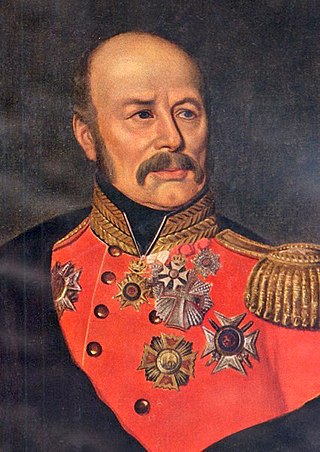
Peter Carl Frederik von Scholten was Governor-General of the Danish West Indies from 1827 to 1848.

Carl Adolph Rothe was a naval officer in the Royal Danish Navy and governor of the Danish West Indies from 1820 to 1822.
Adrian Benjamin Bentzon was Governor of the Danish West Indies from 1816 to 1820.

Sugar production in the United States Virgin Islands was an important part of the economy of the United States Virgin Islands for over two hundred years. Long before the islands became part of the United States in 1917, the islands, in particular the island of Saint Croix, was exploited by the Danish from the early 18th century and by 1800 over 30,000 acres were under cultivation, earning Saint Croix a reputation as the "Garden of the West Indies". Since the closing of the last sugar factory on Saint Croix in 1966, the industry has become only a memory.
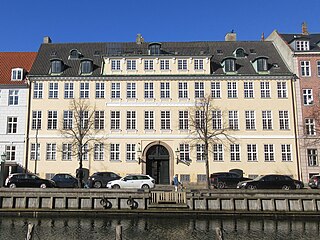
The Heering House is a Neoclassical house overlooking Christianshavn Canal in the Christianshavn neighbourhood of Copenhagen, Denmark. It takes its name after Peter Frederik Suhm Heering (1792-1875) who owned it from 1838 until his death in 1875 and it continued to serve as headquarters for his company, Peter Heering, until 1977. The building is now home to the Nordea Foundation and a museum dedicated to banks and saving banks, as well as six residences available to foreign researchers and specialists.

Arnold Ray Highfield was an American professor, historian, writer, and poet, best known for his historical works on the Danish West Indies and the United States Virgin Islands.

The Danish West India and Guinea Company Warehouse is a historic building located at Church and Company Streets in Christiansted, U.S. Virgin Islands. Built in 1749 for the Danish West India and Guinea Company, the building served as the center of Danish commerce on Saint Croix during the 18th and early 19th centuries. At the time, the U.S. Virgin Islands were known as the Danish West Indies, and Saint Croix had the most successful economy of the three islands. The building is representative of Danish colonial architecture and features stucco walls made of yellow brick imported from Denmark, an inner courtyard, and several cisterns. After its use as a warehouse ended in the 19th century, the building served as a telegraph office; it became a post office and customs house after the United States purchased the islands in 1917.
Frederik Christian Hals von Moth was a Danish merchant, nobleman, colonial administrator and planter who served as Governor-General of St. Thomas and St. John in the Danish West Indies from April 1724 - May 1727 then again from 21 February 1736 - 13 April 1744. In addition, he served as Governor of St. Croix from 8 January 1735 - 15 May 1747. In 1736, his title was changed to Governor General (generalguvernør). His military rank was Commander (kommandørkaptajn). In addition, he held the rank of justitsråd.

Reinhard Iselin was a Danish merchant, shipowner and industrialist who founded Reinhard Iselin & Co. in Copenhagen in 1749. The company completed 65 expeditions to the Danish West Indies. Iselin was also active in the Danish Asiatic Company where he served on the board of directors from 1759 to 1769. He owned Iselingen and Rosenfeldt at Vordingborg. He was raised to the peerage with the rank of baron in 1776 but the title died with him since both his sons died as infants.

Jens Friedenreich Hage was a Danish merchant and landowner.

Vigilant was a Baltimore schooner, possibly originally launched in 1794 as Nonsuch. She appeared in the Danish West Indies as Vigilant from 1824. She carried the mail and passenger traffic between St. Croix and St. Thomas in the 19th and the first decade of the 20th century. A storm sank Vigilant on 12 September 1928.

Frantz Christopher Henrik Hohlenberg was a Danish naval officer who specialised in ship design and had little seagoing experience. He succeeded Ernst Wilhelm Stibolt as Master Shipbuilder (fabriksmester) at the Royal Danish Dockyards in 1796. His ships included five ships of the line and 18 frigates. Three of the ships of the line and nine of the frigates were captured at the 1807 Battle of Copenhagen and subsequently added to the Royal Navy. He resigned after a controversy in 1803.

Frederik Riise was a Danish photographer and exhibition curator. He was a noted portrait photographer and is also remembered for his numerous photographs of buildings, streets and monuments in Copenhagen.
Jens Lind was a Danish sea captain, ship-owner, merchant, slave trader, landowner and industrialist. He was from the late 1780s until 1806 active in the Triangle Trade and was as such responsible for the shipment of somewhere between 1,800 and 2,000 slaves from Guinea to the Danish West Indies, approximately half of them illegally after the abolition of the slave trade in 1803. He was from around 1800 also involved in a substantial number of industrial enterprises, including a brewery at Vandkunsten 8 in Copenhagen and a paper mill, oil mill and soap factory on the Hulemose estate at Vordingborg.
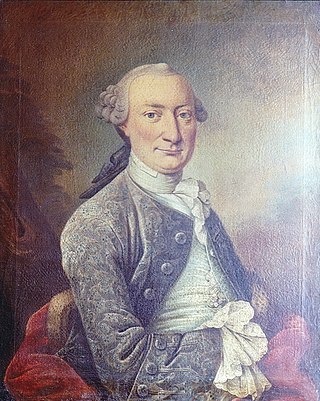
Jens Michelsen Beck was a Danish surveyor, cartographer, landowner and planter. On the island of Saint Croix in the Danish West Indies, he owned the Beck's Grove plantation. Beck later returned to Denmark, settling on Gentoftegård north of Copenhagen. His daughter Christiane was married to Ove Malling.

















